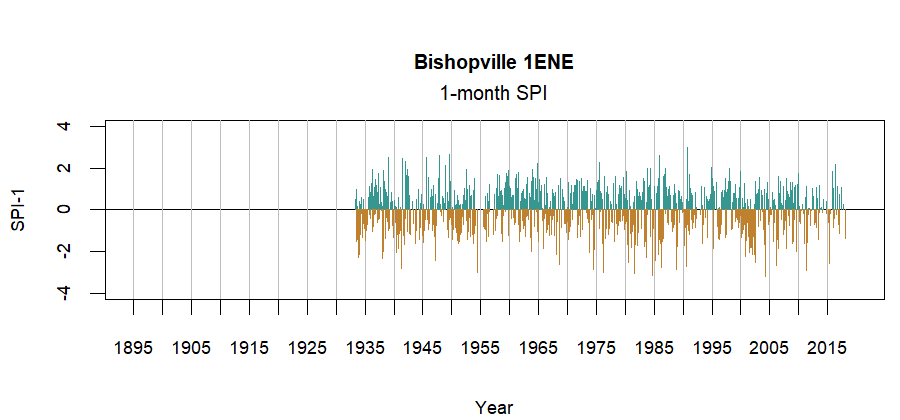Bishopville 1ENE Lee County | SC Climate Division 6 | ID# 380736 ◼ ◼ ◼
Bishopville 1ENE
Location: 34.22 °N, 80.24 °W
Elevation: 224 ft.
Record incorporates data from the following stations: BISHOPVILLE, BISHOPVILLE 1 ENE, BISHOPVILLE 3 W, BISHOPVILLE 8 NNW, BISHOPVILLE 1ENE

Click on legend items to hide or reveal data ![]()
Bishopville 1ENE
Average Monthly Precipitation (in inches)
Data Source: Period of Record — Applied Climate Information System (ACIS); Climate Normals (if available) — NOAA’s National Centers for Environmental Information (NCEI)
Hover over squares for precipitation amounts ![]()
Bishopville 1ENE
Historical Monthly Precipitation (in inches)
(Months with missing data are coded 9999)
Data Source: Applied Climate Information System (ACIS)
Click on legend items to hide or reveal data ![]()
Bishopville 1ENE
Seasonal Precipitation (in inches)
* Data Missing: Feb, Jun, Sep 1990; Jun, Jul, Aug, Sep, Oct, Nov, Dec 1992; Jan 1993; Jul 1994; Aug, Sep 1995; May 2003; Jan 2008; Aug, Nov 2010; Aug, Dec 2011; Feb, Mar, Jul, Sep, Dec 2012; Mar, Jun, Oct, Dec 2013; Mar, Jun, Jul, Aug, Sep, Dec 2014; Jan, Mar, Jun, Aug, Sep, Oct, Dec 2015; Mar, Jun, Aug, Dec 2016; Mar, Apr, Jun, Jul, Aug, Sep, Nov, Dec 2017; Jan, Mar, Apr, May, Jun, Jul, Aug, Sep, Oct, Nov, Dec 2018.
Data Source: Applied Climate Information System (ACIS)
Click on legend label to hide and reveal lines connecting data
hover over points for more info
![]()
Bishopville 1ENE
Maximum Event Precipitation since 1980 (in inches)
Note: Some duration periods may overlap; the
longest duration appears on top.
Years with missing data are coded -9999.
Click on column headers to sort data
![]()
Maximun Event Precipitation for the Historic Record (in inches)
Data Source: Applied Climate Information System (ACIS)
1-Month 2-Month 3-Month 6-Month 9-Month 12-Month 24-Month All Multi-Duration

Data Source: Applied Climate Information System (ACIS)
12-month 18-month 24-month 36-month 48-month 60-month

Data Source: Applied Climate Information System (ACIS)



 This chart shows the range and probability of specific precipitation totals. For example, there is about a 2% chance of getting just 35 inches of precipitation in a year. But if you look at the distribution of rainfall (historical rainfall amounts are shown by the blue bars, while the line graph smooths out this distribution), you can see that most years you are likely to get more precipitation than 35 inches.
This chart shows the range and probability of specific precipitation totals. For example, there is about a 2% chance of getting just 35 inches of precipitation in a year. But if you look at the distribution of rainfall (historical rainfall amounts are shown by the blue bars, while the line graph smooths out this distribution), you can see that most years you are likely to get more precipitation than 35 inches.